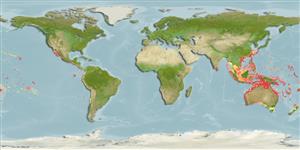>
Mulliformes (Goatfishes) >
Mullidae (Goatfishes)
Etymology: Parupeneus: Latin, parum, parvum = small + Peneus, the name of a river.
More on author: Bleeker.
Environment: milieu / climate zone / depth range / distribution range
Écologie
marin; saumâtre récifal; profondeur 10 - 80 m (Ref. 90102). Tropical; 30°N - 50°S
Western Pacific: Japan to Western Australia, New Caledonia and northern New Zealand. Recently reported from Tonga (Ref. 53797).
Taille / Poids / Âge
Maturity: Lm ? range ? - ? cm
Max length : 50.0 cm TL mâle / non sexé; (Ref. 9002)
Épines dorsales (Total) : 8; Rayons mous dorsaux (Total) : 9; Épines anales: 1; Rayons mous anaux: 7.
Inhabits coastal reefs and estuaries (Ref. 9002); in Indonesia mainly found on deep reefs adjacent to strong currents (Ref. 90102). Juveniles found in small schools; adults singly or in small aggregations (Ref. 9002, 48636). May also be solitary. It is rare in the East Indian region, and found only in cool areas of upwelling; but is common in subtropical latitudes (Ref. 90102).
Life cycle and mating behavior
Maturities | Reproduction | Spawnings | Egg(s) | Fecundities | Larves
Randall, J.E., G.R. Allen and R.C. Steene, 1990. Fishes of the Great Barrier Reef and Coral Sea. University of Hawaii Press, Honolulu, Hawaii. 506 p. (Ref. 2334)
Statut dans la liste rouge de l'IUCN (Ref. 130435)
Menace pour l'homme
Harmless
Utilisations par l'homme
Pêcheries: commercial
Outils
Articles particuliers
Télécharger en XML
Sources Internet
Estimates based on models
Preferred temperature (Ref.
123201): 18 - 28.7, mean 27.2 °C (based on 446 cells).
Phylogenetic diversity index (Ref.
82804): PD
50 = 0.5000 [Uniqueness, from 0.5 = low to 2.0 = high].
Bayesian length-weight: a=0.01259 (0.00753 - 0.02106), b=3.04 (2.90 - 3.18), in cm total length, based on LWR estimates for this species & Genus-body shape (Ref.
93245).
Niveau trophique (Ref.
69278): 3.5 ±0.2 se; based on diet studies.
Résilience (Ref.
120179): Milieu, temps minimum de doublement de population : 1,4 à 4,4 années (Preliminary K or Fecundity.).
Fishing Vulnerability (Ref.
59153): Moderate vulnerability (40 of 100).
Nutrients (Ref.
124155): Calcium = 25.9 [12.6, 57.8] mg/100g; Iron = 0.268 [0.134, 0.621] mg/100g; Protein = 18.1 [14.8, 21.2] %; Omega3 = 0.13 [0.07, 0.25] g/100g; Selenium = 55.7 [26.1, 153.8] μg/100g; VitaminA = 164 [29, 748] μg/100g; Zinc = 0.573 [0.339, 1.075] mg/100g (wet weight);
